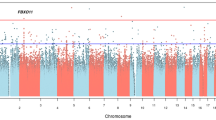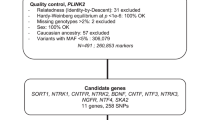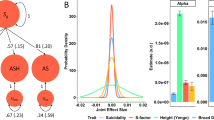Abstract
The complex etiology of suicidal behavior has frequently been investigated in relation to monoaminergic neurotransmission, but other neurosystems have shown alterations as well, involving excitatory glutamatergic and inhibitory γ-aminobutyric acid (GABA) molecular components, together with the modulating polyamines. Sufficiently powered and family-based association studies of glutamatergic and GABAergic genes with suicidal behavior are nonexistent, but several studies have been reported for polyamines. We therefore conducted, for the first time ever, an extensive family-based study of 113 candidate single-nucleotide polymorphisms (SNPs) located in 24 glutamatergic and GABA genes, in addition to interrelated polyaminergic genes, on the outcome of severe suicide attempts (SAs). The family-based analysis (n=660 trios) was supplemented with gene–environment interaction (G × E), case–control (n=519 controls) and subgroup analyses. The main observations were the previously unreported association and linkage of SNPs rs2268115 and rs220557 in GRIN2B, as well as of SNPs rs1049500 and rs2302614 in ODC1 (P<10−2). Furthermore, GRIN2B haplotypic associations were observed, in particular with a four-SNP AGGC haplotype (rs1805247–rs1806201–rs1805482–rs2268115; P<10−5), and a third SNP rs7559979 in ODC1 showed G × E with serious childhood/adolescent physical assault (P<10−4). SA subjects were characterized by transdiagnostic trait anger and past year alcohol–drug use disorders, but not by alcohol–drug use at SA, depression, anxiety or psychosis diagnoses. We also discuss a first ever confirmatory observation of SNP rs6526342 (polyaminergic SAT1) in SA, originally identified in completed suicides. The results suggest that specific genetic variants in a subset of glutamatergic (GRIN2B) and polyaminergic (ODC1) neurosystem genes may be of importance in certain suicidal subjects.
This is a preview of subscription content, access via your institution
Access options
Subscribe to this journal
Receive 12 print issues and online access
$259.00 per year
only $21.58 per issue
Buy this article
- Purchase on Springer Link
- Instant access to full article PDF
Prices may be subject to local taxes which are calculated during checkout


Similar content being viewed by others
References
Mann JJ . Neurobiology of suicidal behaviour. Nat Rev Neurosci 2003; 4: 819–828.
Wasserman D, Sokolowski M, Wasserman J, Rujescu D . Neurobiology and the genetics of suicide. In: Wasserman D, Wasserman C (eds). Oxford Textbook of Suicidology—The Five Continents Perspective. Oxford University Press: Oxford, UK, 2009, pp 165–182.
Wasserman D, Terenius L, Wasserman J, Sokolowski M . The 2009 Nobel conference on the role of genetics in promoting suicide prevention and the mental health of the population. Mol Psychiatry 2010; 15: 12–17.
Mann JJ, Arango V, Avenevoli S, Brent D, Champagne F, Clayton P et al. Candidate endophenotypes for genetic studies of suicidal behavior. Biol Psychiatry 2009; 65: 556–563.
Voracek M, Loibl LM . Genetics of suicide: a systematic review of twin studies. Wien Klin Wochenschr 2007; 119: 463–475.
Rujescu D, Giegling I . The genetics of neurosystems in mental ill-health and suicidality: beyond serotonin. Eur Psychiatry 2010; 25: 272–274.
Currier D, Mann JJ . Stress, genes and the biology of suicidal behavior. Psychiatr Clin North Am 2008; 31: 247–269.
Ernst C, Mechawar N, Turecki G . Suicide neurobiology. Prog Neurobiol 2009; 89: 315–333.
Meyer-Lindenberg A, Weinberger DR . Intermediate phenotypes and genetic mechanisms of psychiatric disorders. Nat Rev Neurosci 2006; 7: 818–827.
Brodsky BS, Stanley B . Adverse childhood experiences and suicidal behavior. Psychiatr Clin North Am 2008; 31: 223–235.
Caspi A, Hariri AR, Holmes A, Uher R, Moffitt TE . Genetic sensitivity to the environment: the case of the serotonin transporter gene and its implications for studying complex diseases and traits. Am J Psych 2010; 167: 509–527.
Rao VR, Finkbeiner S . NMDA and AMPA receptors: old channels, new tricks. Trends Neurosci 2007; 30: 284–291.
McCool BA, Christian DT, Diaz MR, Läck AK . Glutamate plasticity in the drunken amygdala: the making of an anxious synapse. Int Rev Neurobiol 2010; 91: 205–233.
Gao S-F, Bao A-M . Corticotropin-releasing hormone, glutamate, and γ-aminobutyric acid in depression. Neuroscientist 2011; 17: 124–144.
Hashimoto K . Emerging role of glutamate in the pathophysiology of major depressive disorder. Brain Res Rev 2009; 61: 105–123.
Riaza Bermudo-Soriano C, Perez-Rodriguez MM, Vaquero-Lorenzo C, Baca-Garcia E . New perspectives in glutamate and anxiety. Pharmacol Biochem Behav 2011; 100: 752–774.
Cherlyn SYT, Woon PS, Liu JJ, Ong WY, Tsai GC, Sim K . Genetic association studies of glutamate, GABA and related genes in schizophrenia and bipolar disorder: a decade of advance. Neurosci Biobehav Rev 2010; 34: 958–977.
Sequeira A, Mamdani F, Ernst C, Vawter MP, Bunney WE, Lebel V et al. Global brain gene expression analysis links glutamatergic and GABAergic alterations to suicide and major depression. PLoS One 2009; 4: e6585.
Freed WJ, Dillon-Carter O, Kleinman JE . Properties of [3H]AMPA binding in postmortem human brain from psychotic subjects and controls: increases in caudate nucleus associated with suicide. Exp Neurol 1993; 121: 48–56.
Noga JT, Hyde TM, Herman MM, Spurney CF, Bigelow LB, Weinberger DR et al. Glutamate receptors in the postmortem striatum of schizophrenic, suicide, and control brains. Synapse 1997; 27: 168–176.
Kalkman HO . Circumstantial evidence for a role of glutamine-synthetase in suicide. Med Hypotheses 2011; 76: 905–907.
Nowak G, Ordway GA, Paul IA . Alterations in the N-methyl-D-aspartate (NMDA) receptor complex in the frontal cortex of suicide victims. Brain Res 1995; 675: 157–164.
Nowak G, Szewczyk B, Sadlik K, Piekoszewski W, Trela F, Florek E et al. Reduced potency of zinc to interact with NMDA receptors in hippocampal tissue of suicide victims. Pol J Pharmacol 2003; 55: 455–459.
Steiner J, Walter M, Gos T, Guillemin GJ, Bernstein H-G, Sarnyai Z et al. Severe depression is associated with increased microglial quinolinic acid in subregions of the anterior cingulate gyrus: evidence for an immune-modulated glutamatergic neurotransmission? J Neuroinflammation 2011; 8: 94.
DiazGranados N, Ibrahim LA, Brutsche NE, Ameli R, Henter ID, Luckenbaugh DA et al. Rapid resolution of suicidal ideation after a single infusion of an N-methyl-D-aspartate antagonist in patients with treatment-resistant major depressive disorder. J Clin Psychiatry 2010; 71: 1605–1611.
Manchon M, Kopp N, Rouzioux JJ, Lecestre D, Deluermoz S, Miachon S . Benzodiazepine receptor and neurotransmitter studies in the brain of suicides. Life Sci 1987; 41: 2623–2630.
Pandey GN, Conley RR, Pandey SC, Goel S, Roberts RC, Tamminga CA et al. Benzodiazepine receptors in the post-mortem brain of suicide victims and schizophrenic subjects. Psychiatry Res 1997; 71: 137–149.
Marazziti D, Dell’Osso B, Baroni S, Masala I, Di Nasso E, Giannaccini G et al. Decreased density of peripheral benzodiazepine receptors in psychiatric patients after a suicide attempt. Life Sci 2005; 77: 3268–3275.
Sequeira A, Klempan T, Canetti L, Ffrench-Mullen J, Benkelfat C, Rouleau GA et al. Patterns of gene expression in the limbic system of suicides with and without major depression. Mol Psychiatry 2007; 12: 640–655.
Klempan TA, Sequeira A, Canetti L, Lalovic A, Ernst C, Ffrench-Mullen J et al. Altered expression of genes involved in ATP biosynthesis and GABAergic neurotransmission in the ventral prefrontal cortex of suicides with and without major depression. Mol Psychiatry 2009; 14: 175–189.
Merali Z, Du L, Hrdina P, Palkovits M, Faludi G, Poulter MO et al. Dysregulation in the suicide brain: mRNA expression of corticotropin-releasing hormone receptors and GABA(A) receptor subunits in frontal cortical brain region. J Neurosci 2004; 24: 1478–1485.
Poulter MO, Du L, Weaver ICG, Palkovits M, Faludi G, Merali Z et al. GABAA receptor promoter hypermethylation in suicide brain: implications for the involvement of epigenetic processes. Biol Psychiatry 2008; 64: 645–652.
Poulter MO, Du L, Zhurov V, Palkovits M, Faludi G, Merali Z et al. Altered organization of GABA(A) receptor mRNA expression in the depressed suicide brain. Front Mol Neurosci 2010; 3: 3.
Fiori LM, Wanner B, Jomphe V, Croteau J, Vitaro F, Tremblay RE et al. Association of polyaminergic loci with anxiety, mood disorders, and attempted suicide. PLoS One 2010; 5: e15146.
Fiori LM, Bureau A, Labbe A, Croteau J, Noël S, Mérette C et al. Global gene expression profiling of the polyamine system in suicide completers. Int J Neuropsychopharmacol 2011; 14: 595–605.
Chen GG, Fiori LM, Moquin L, Gratton A, Mamer O, Mechawar N et al. Evidence of altered polyamine concentrations in cerebral cortex of suicide completers. Neuropsychopharmacology 2010; 35: 1477–1484.
Strømgaard K, Mellor I . AMPA receptor ligands: synthetic and pharmacological studies of polyamines and polyamine toxins. Med Res Rev 2004; 24: 589–620.
Mony L, Kew JNC, Gunthorpe MJ, Paoletti P . Allosteric modulators of NR2B-containing NMDA receptors: molecular mechanisms and therapeutic potential. Br J Pharmacol 2009; 157: 1301–1317.
Laje G, Paddock S, Manji H, Rush AJ, Wilson AF, Charney D et al. Genetic markers of suicidal ideation emerging during citalopram treatment of major depression. Am J Psychiatry 2007; 164: 1530–1538.
Brent D, Melhem N, Turecki G . Pharmacogenomics of suicidal events. Pharmacogenomics 2011; 11: 793–807.
Fiori LM, Turecki G . Genetic and epigenetic influences on expression of spermine synthase and spermine oxidase in suicide completers. Neuropsychopharmacology 2010; 13: 725–736.
Fiori LM, Mechawar N, Turecki G . Identification and characterization of spermidine/spermine N1-acetyltransferase promoter variants in suicide completers. Biol Psychiatry 2009; 66: 460–467.
Sequeira A, Gwadry FG, Ffrench-Mullen JMH, Canetti L, Gingras Y, Casero RA et al. Implication of SSAT by gene expression and genetic variation in suicide and major depression. Arch Gen Psychiatry 2006; 63: 35–48.
Ober C, Loisel DA, Gilad Y . Sex-specific genetic architecture of human disease. Nat Rev Genet 2008; 9: 911–922.
Wasserman D, Geijer T, Rozanov V, Wasserman J . Suicide attempt and basic mechanisms in neural conduction: relationships to the SCN8A and VAMP4 genes. Am J Med Genet B Semin Med Genet 2005; 133B: 116–119.
Ben-Efraim YJ, Wasserman D, Wasserman J, Sokolowski M . Gene-environment interactions between CRHR1 variants and physical assault in suicide attempts. Genes Brain Behav 2011; 10: 663–672.
Wasserman D, Wasserman J, Rozanov V, Sokolowski M . Depression in suicidal males: genetic risk variants in the CRHR1 gene. Genes Brain Behav 2009; 8: 72–79.
Wasserman D, Sokolowski M, Rozanov V, Wasserman J . The CRHR1 gene: a marker for suicidality in depressed males exposed to low stress. Genes Brain Behav 2008; 7: 14–19.
Spielberger C . State-Trait Anger Expression Inventory. Psychological Assessment Resources: Orlando, FL, 1988.
Plutchik R, van Praag HM . A self-report measure of violence risk, II. Compr Psychiatry 1990; 31: 450–456.
Browning BL, Browning SR . A unified approach to genotype imputation and haplotype-phase inference for large data sets of trios and unrelated individuals. Am J Hum Genet 2009; 84: 210–223.
Barrett JC, Fry B, Maller J, Daly MJ . Haploview: analysis and visualization of LD and haplotype maps. Bioinformatics 2005; 21: 263–265.
Cordell HJ, Clayton DG . A unified stepwise regression procedure for evaluating the relative effects of polymorphisms within a gene using case/control or family data: application to HLA in type 1 diabetes. Am J Hum Genet 2002; 70: 124–141.
Hoffmann TJ, Lange C, Vansteelandt S, Laird NM . Gene-environment interaction tests for dichotomous traits in trios and sibships. Genet Epidemiol 2009; 33: 691–699.
Zandi PP, Belmonte PL, Willour VL, Goes FS, Badner JA, Simpson SG et al. Association study of Wnt signaling pathway genes in bipolar disorder. Arch Gen Psychiatry 2008; 65: 785–793.
Zou GY . On the estimation of additive interaction by use of the four-by-two table and beyond. Am J Epidemiol 2008; 168: 212–224.
Stephens M, Smith NJ, Donnelly P . A new statistical method for haplotype reconstruction from population data. Am J Hum Genet 2001; 68: 978–989.
Storey JD, Tibshirani R . Statistical significance for genomewide studies. Proc Natl Acad Sci USA 2003; 100: 9440–9445.
Gauderman WJ . Sample size requirements for matched case-control studies of gene-environment interaction. Stat Med 2002; 21: 35–50.
Kuzmiski JB, Marty V, Baimoukhametova DV, Bains JS . Stress-induced priming of glutamate synapses unmasks associative short-term plasticity. Nat Neurosci 2010; 13: 1257–1264.
Herman JP, Mueller NK, Figueiredo H . Role of GABA and glutamate circuitry in hypothalamo-pituitary-adrenocortical stress integration. Ann NY Acad Sci 2004; 1018: 35–45.
Ziegler DR, Cullinan WE, Herman JP . Organization and regulation of paraventricular nucleus glutamate signaling systems: N-methyl-D-aspartate receptors. J Comp Neurol 2005; 484: 43–56.
Mann JJ, Currier D . A review of prospective studies of biologic predictors of suicidal behavior in mood disorders. Arch Suicide Res 2007; 11: 3–16.
Endele S, Rosenberger G, Geider K, Popp B, Tamer C, Stefanova I et al. Mutations in GRIN2A and GRIN2B encoding regulatory subunits of NMDA receptors cause variable neurodevelopmental phenotypes. Nat Genet 2010; 42: 1021–1026.
Mori F, Ribolsi M, Kusayanagi H, Siracusano A, Mantovani V, Marasco E et al. Genetic variants of the NMDA receptor influence cortical excitability and plasticity in humans. J Neurophysiol 2011; 106: 1637–1643.
Ness V, Arning L, Niesert HE, Stuettgen MC, Epplen JT, Beste C . Variations in the GRIN2B gene are associated with risky decision-making. Neuropharmacology 2011; 61: 950–956.
Beste C, Baune BT, Domschke K, Falkenstein M, Konrad C . Dissociable influences of NR2B-receptor related neural transmission on functions of distinct associative basal ganglia circuits. Neuroimage 2010; 52: 309–315.
Gilad GM, Gilad VH . Overview of the brain polyamine-stress-response: regulation, development, and modulation by lithium and role in cell survival. Cell Mol Neurobiol 2003; 23: 637–649.
Guipponi M, Deutsch S, Kohler K, Perroud N, Le Gal F, Vessaz M et al. Genetic and epigenetic analysis of SSAT gene dysregulation in suicidal behavior. Am J Med Genet B Semin Med Genet 2009; 150B: 799–807.
Owen JM . Transdiagnostic cognitive processes in high trait anger. Clin Psychol Rev 2011; 31: 193–202.
Fulwiler CE, King JA, Zhang N . Amygdala-orbitofrontal resting-state functional connectivity is associated with trait anger. NeuroReport 2012; 23: 606–610.
Turecki G . Dissecting the suicide phenotype: the role of impulsive-aggressive behaviours. J Psychiatr Neurosci 2005; 30: 398–408.
Heinz AJ, Beck A, Meyer-Lindenberg A, Sterzer P, Heinz A . Cognitive and neurobiological mechanisms of alcohol-related aggression. Nat Rev Neurosci 2011; 12: 400–413.
Ron D, Wang J . The NMDA receptor and alcohol addiction. In: Van Dongen A (ed). Biology of the NMDA Receptor. CRC Press: Boca Raton (FL), 2009 [cited 28 January 2012].
Wills TA, Klug JR, Silberman Y, Baucum AJ, Weitlauf C, Colbran RJ et al. GluN2B subunit deletion reveals key role in acute and chronic ethanol sensitivity of glutamate synapses in bed nucleus of the stria terminalis. Proc Natl Acad Sci USA 2012; 109: E278–E287.
Bevilacqua L, Carli V, Sarchiapone M, George DK, Goldman D, Roy A et al. Interaction between FKBP5 and childhood trauma and risk of aggressive behavior. Arch Gen Psych 2012; 69: 62–70.
Botto LD, Khoury MJ . Commentary: facing the challenge of gene-environment interaction: the two-by-four table and beyond. Am J Epidemiol 2001; 153: 1016–1020.
Acknowledgements
We thank all interviewers at the Human Ecological Health organization/Odessa National Mechnikov University, Odessa, Ukraine; Professor Vsevolod Rozanov for coordination of the material collection in Ukraine; Dr Vladymyr Bogatov and laboratory technician Lars Holmberg for technical assistance; Dr Tatyana Reytarova for logistic assistance; and all those who have given their consent to participate as research subjects in this study. We thank the SNP&SEQ Technology Platform at Uppsala University for their excellent quality of services and expertise in the genotyping conducted. The study was funded by the Marianne and Marcus Wallenberg Foundation, the Knut and Alice Wallenberg Foundation and the American Foundation for Suicide Prevention.
Author information
Authors and Affiliations
Corresponding author
Ethics declarations
Competing interests
The authors declare no conflict of interest.
Additional information
Supplementary Information accompanies the paper on the Molecular Psychiatry website
Supplementary information
PowerPoint slides
Rights and permissions
About this article
Cite this article
Sokolowski, M., Ben-Efraim, Y., Wasserman, J. et al. Glutamatergic GRIN2B and polyaminergic ODC1 genes in suicide attempts: associations and gene–environment interactions with childhood/adolescent physical assault. Mol Psychiatry 18, 985–992 (2013). https://doi.org/10.1038/mp.2012.112
Received:
Revised:
Accepted:
Published:
Issue Date:
DOI: https://doi.org/10.1038/mp.2012.112
Keywords
This article is cited by
-
Identification of potential blood biomarkers associated with suicide in major depressive disorder
Translational Psychiatry (2022)
-
Altered anterior cingulate glutamatergic metabolism in depressed adolescents with current suicidal ideation
Translational Psychiatry (2020)
-
FoxO1, A2M, and TGF-β1: three novel genes predicting depression in gene X environment interactions are identified using cross-species and cross-tissues transcriptomic and miRNomic analyses
Molecular Psychiatry (2018)
-
Cortical inhibitory markers of lifetime suicidal behavior in depressed adolescents
Neuropsychopharmacology (2018)
-
Precision medicine for suicidality: from universality to subtypes and personalization
Molecular Psychiatry (2017)



